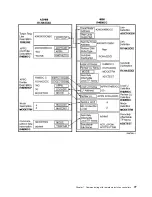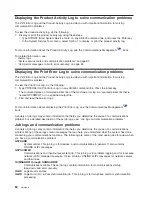
Chapter 8. Troubleshooting communications problems
If you suspect you have a problem with communications connectivity, the AS/400 system provides a set of
tools to help you with problem analysis tasks. The list below contains some of the more common tools for
communications problem analysis.
You can do the following to identify communication problems:
v
“Displaying message queues to solve communication problems”
v
“Displaying the Product Activity Log to solve communication problems” on page 80
v
“Displaying the Print Error Log to solve communication problems” on page 80
You can do the following to solve communication problems:
v
“Solving communication problems using communications trace” on page 81
v
“Solving communication problems using the system problem log” on page 83
v
“Solving communication problems using status information” on page 84
v
“Considerations for system tuning during error recovery” on page 84
v
“Using error messages to aid in error recovery” on page 84
In addition, when a local system rejects an incoming program start request, a message is sent to the
system operator message queue. You can use reason codes to determine why the program start request
was rejected.
Displaying message queues to solve communication problems
Message queues receive some messages that are related to communications failures. The message lists
possible causes of the problem and additional information, depending on the problem, and the suggested
problem analysis tool.
To display message queues, follow these steps:
1. On the AS/400 command line, type DSPMSG MSGQ(XXXX), in which XXXX may be:
v
The message queue identified by the QCFGMSGQ system value
– The default value is QSYSOPR
– Or, message queue if the system value has been changed
v
For lines, controllers, and devices which support the MSGQ parameter, the message queue is
specified in the configuration object
v
For display devices, the message queue that matches the device name
2. Press the Enter key.
3. In the Display Message display, read the messages pertaining to communications problems that are
displayed in the message queue. The object name in the message directs you to the communications
objects in error.
4. For messages in the queue with an * in the farthest left position, press F14 to perform additional tests.
This calls the Work with Problems tool.
For related information, see:
v
Message queues
v
“Solving communication problems using the system problem log” on page 83
v
“Job logs and communication problems” on page 80
v
“System service tools and communication problems” on page 82
v
“Using error messages to aid in error recovery” on page 84
© Copyright IBM Corp. 1998, 2001
79
Summary of Contents for AS/400
Page 1: ...iSeries Networking iSeries Communications Management ERserver...
Page 2: ......
Page 3: ...iSeries Networking iSeries Communications Management ERserver...
Page 8: ...2 Version 5...
Page 10: ...4 Version 5...
Page 12: ...6 Version 5...
Page 22: ...For more information about creating subsystems see the Work Management book 16 Version 5...
Page 26: ...20 Version 5...
Page 34: ...Example 3 AS 400 system for DLUR support with the host system 28 Version 5...
Page 36: ...30 Version 5...
Page 46: ...40 Version 5...
Page 57: ...Chapter 7 Communicating with remote workstation controllers 51...
Page 63: ...Chapter 7 Communicating with remote workstation controllers 57...
Page 82: ...Example 2 AS 400 to 4690 PEER connection over token ring network 76 Version 5...
Page 83: ...Chapter 7 Communicating with remote workstation controllers 77...
Page 84: ...78 Version 5...
Page 102: ...96 Version 5...
Page 103: ......
Page 104: ...Printed in U S A...






























